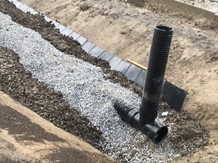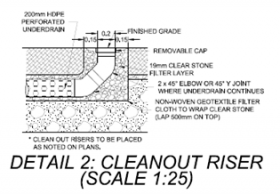Construction: communication, inspection plan, and utilities coordination
Pre-construction: communication, inspection plan, and utilities coordination[edit]
After securing a contractor, a pre-construction meeting between the project manager, project engineer, and contractor will facilitate an efficient job site and reduce the potential for miscommunication. These meetings should cover:
- LID design details and construction notes
- material specifications, inspections, and chain-of-custody
- access routes and storage areas
- protection of LID practices: phasing, ESC, and perimeter fencing
- equipment requirements and recommendations
- verification of field changes
- plant establishment and warranty-period maintenance
- ownership and assumption protocols
- project inspection plan
- verification processes for field changes to the design and material substitutions
The table below expands upon the bullets above and provides helpful guidance on communication topics at the pre-construction meeting. Given the lead-up time needed for testing requirements of specified materials, these discussions should occur soon after the contract is awarded, ideally 2 months prior to project construction.
| Communication topic | Guidance |
|---|---|
| LID design details and construction notes | -Provide overview of LID design, ideally through a design brief.
-Discuss LID design details and construction notes, and ensure details and notes are understood by all parties involved. -Discuss project phasing and general timeliness. |
| Material specifications, inspections, and chain-of-custody | -Material substitutions must be confirmed by the project engineer.
-Material testing requirements and their timelines must be understood by all parties, including who is responsible for testing. -Material acceptance protocols, with chain of custody, should be understood by all parties, including who is responsible if the material fails. -Biomedia manufacturing and testing should start prior to construction, ideally 2 months in advance. |
| Access routes and storage areas | -Discuss access to the site along with material and equipment storage with the contractor.
-Material storage should be downstream of LID features. -Heavy equipment routes should be agreed on to minimize impact to the LID feature and protected areas. |
| Protection of LID practices during construction: phasing, ESC, and perimeter controls | -Review and discuss the ESC plan.
-Discuss frequency of ESC inspection, protocols for repair and replacement and, parties responsible. -Discuss communication protocols for sediment contamination. -Discuss rehabilitation protocols for sediment contamination and parties responsible. |
| Equipment requirements and recommendations | -Wide track, low-ground pressure vehicles are recommended to minimize compaction.
-Excavation should occur from outside of LID feature whenever possible. See Excavation. -Gravel and biomedia should be installed by a slinger truck outside of practice whenever possible. -Avoid heavy machinery within LID footprint whenever possible. |
| Verification of field changes | -The project engineer must verify all field changes to materials and design.
-In the design engineer’s absence, the project manager should verify field changes. |
| Plant establishment and warranty-period maintenance | -Discuss planting timelines at the pre-construction meeting.
-Avoid planting in the summer months (June, July and August). Fall planting is the ideal scenario. -Plants will require regular maintenance (irrigation and weeding) to ensure establishment, especially over the first year. -Ensure that plant maintenance and its frequency is understood by responsible parties. -Plant deficiencies should be addressed prior to warranty period initiating. |
| Ownership and assumption protocols | -Discuss how testing will confirm LID practice functionality according to assumption protocols. |
| Project inspection plan | -Project inspection plan should be detailed and understood by all parties.
-Sign off by all parties involved on photos, video, and social media post may be required. |
Inspection plan[edit]
The STEP LID Stormwater Management Inspection and Maintenance Guide gives detailed guidance on how to conduct construction inspections for LID practices. Generally, construction inspections should be continuous as the work progresses. If this isn’t possible, critical inspection points are:
- site preparation
- excavation
- installation of pipes, granular, and biomedia
- finishing grades
- surface treatment installation: pavers, plants, porous concrete, etc.
- after rain events (see ESC inspection and maintenance)
- whenever sub-contractors or utilities begin work (hand-off points)
The last element—inspection of sub-contractors—requires further comment. For example, if a sub-contractor is installing the curbing, they need to understand the purpose of the curbing and curb cuts, i.e., that they are meant to direct water into the LID facility, not to the closest catch basin. Without this knowledge, the sub-contractor may mistakenly build the curbs as they usually do: to direct water into a catchbasin.
Utilities coordination[edit]
Similarly, if the LID practice is in close proximity to sub-surface utilities, the utility owner may use their own contractors to perform related work. If this is the case, these sub-contractors must also be made aware of the LID practice’s purpose, how compaction affects performance, keeping the LID practice clear of excavated dirt and generally how their work could impede the construction and performance of the LID practice. In general, communication between the contractors, project managers, and project engineers should be frequent and open.

